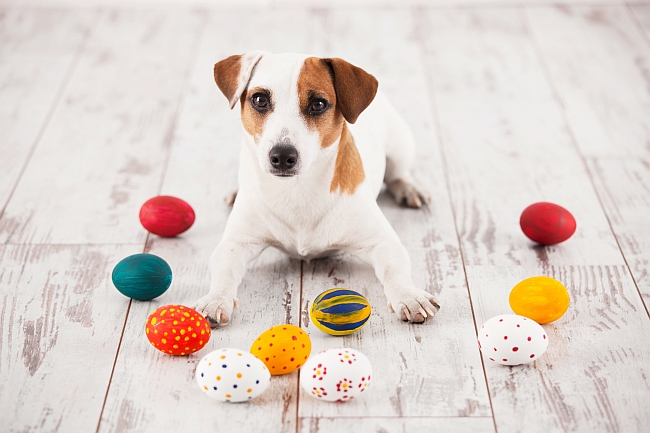
Easter is a wonderful celebration of family, friends and new life in the season of Spring. With brightly colored eggs, candies, overflowing Easter baskets, bunny-shaped cakes, and a wide variety of delicious goodies, this holiday is an exciting time for all! All people, that is. Dogs and cats actually can be easily disregarded in all the festivities and Easter-egg hunts, leaving them vulnerable to the many hazards that accompany this occasion. Find out the top threats that dogs and cats face during Easter, so that you will know how to protect them while still having an enjoyable holiday with your family.
Easter eggs: Remember that strong, vinegary smell of the Easter egg dye you used as a kid? Fortunately, the colors and dye are not toxic for pets, nor are natural egg shells dangerous for consumption. However, the plastic shells of Easter eggs (as well as the tin foil candy wrappers of the treats inside) can be tempting to dogs. Easter eggs are potential canine chew toys, and can be easily bitten through and swallowed if the pet parents are not careful to keep the vibrant shells away from the pups. Once the kids have opened the eggs they found, make sure they dispose of the shells in a large trash can (or a box you can use for next year).
Chocolate bunnies, eggs, crosses, etc. As most pet owners know, chocolate is poisonous for pets. The caffeine and theobromine in chocolate can cause vomiting, shock, and seizures depending on the potency and dosage consumed. So keep an eye on your dog to make sure he doesn’t bite the ears off of your child’s chocolate Easter bunny!
Marshmallow chicks, jelly beans, candies, etc. If your dog accidentally has a few bites of sugary candy it might not seem like the end of the world, but candy is actually dangerous for dogs. Xylitol, the artificial sweetener used in confection like jelly beans, etc. can be quite toxic. Keep your pup away from those Easter basket goodies.
Faux grass in Easter baskets: Have we mentioned cats often have pica and like chewing on stringy, plastic, yarn or wooly substances? The shiny plastic grass often used to stuff Easter baskets can prove dangerous for the cat’s digestive system or even cause them to choke if they were to eat it. Instead of using this false grass, use a paper option or real grass instead since these are far less detrimental.
Easter lilies: Not all house plants are safe to keep around cats, and among the wild flowers we often display, Easter lilies are among the more dangerous plants for pets to be exposed to. If ingested, the dog or cat might appear lethargic or nauseous, even vomiting or having diarrhea. If your dog or cat eats either the leaves or petals of Easter lilies, daffodils or other springtime flower bouquets, be sure to call the Pet Poison Helpline: 855-213-6680 or your vet immediately.
Easter toys: Frequently in pre-made Easter baskets there are toys for children to play with. These can be anything from bouncy rubber balls, to pop guns, toy cars, small dollies, stuffed animals, water guns, or small-object plastic toys that look appealing to curious dogs and cats. Rubber and plastic might feel good to chew on, and could get stuck in an animal’s teeth or lodged in their throats. If you can, choose baskets with larger toys that do not have small parts.
Baby animals: Some families like to bring their children and pets to petting zoos and farms, or have baby animals around for the Easter egg hunt celebration. Not only do tiny animals like chicks, bunnies and ducks look like walking tasty targets to dogs, but they also can carry bacteria like salmonella that can cause pets to get sick. Avoid potential carnage and illness by keeping the pets inside while the adorable farm animals wander around your yard.
Rotten eggs: In the days following Easter there might be scraps of eggs left over in the yard. Dog noses will quickly find these scraps in the grass and bushes, and if they are interested enough, might result in sampling the stinky egg bits. This could lead to upset stomachs at best, and salmonella, vomiting, diarrhea at worst. Be sure to give your lawn a good once-over to ensure that any toxic, rotten, bite-sized, or potentially dangerous items are thrown in the trash before you let your dog out to play.

